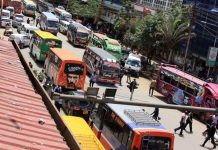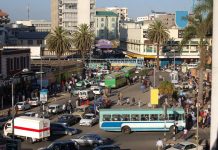For the past one week, we have been talking about the lopsided contract that Kenya signed to build and run the Standard Gauge Railway.
It seems we have now perfected the art of signing such deals with foreign companies without caring about the long-term effects.
Recently, I stumbled upon a once-tightly held franchise and contract that was signed to allow a British company to continue running a monopoly bus service in Nairobi and Mombasa.
Here is the story.
Monday afternoon, May 3, 1965: Discussions were opened between a London-based transport company and City Hall on how to run the colonial-era Kenya Bus Service that was operating in Nairobi.
Months later, a scandalous new agreement — nay, monopoly — was put in place and the fine print was only found out 10 years later. Had things gone right, we wouldn’t be having the current transport problems that face Nairobi.
This agreement was more of a con game than a business. Here is why. To exclusively use the bus station at the heart of Nairobi, City Hall officials and some remnants of colonial-era civil servants allowed Kenya Bus Service to only pay Sh60 per day as ground rent for the 1.8 acres. This translated to Sh21,000 per year for all that space.
Why city mandarins Simeon Getonga, Charles Rubia, Yunis Ali, and J.P. Mbogua agreed to such a deal is not clear.
The company had just been asked to vacate Queensway Bus Terminus, which was located on the grounds of the modern-day Hilton Hotel, and which had been given to an American investor to build a tourist hotel.
The colonial government had given Kenya Bus a monopoly and would not allow any other entrant on the city routes. And when the time to review the future of Kenya Bus came after independence, it is now clear Nairobi city got the short end of the stick.
During that 1956 meeting attended by City Treasurer A.W. Kents and KBS Chairman A.R. Walters, it was agreed that City Hall would “undertake to make and enforce an appropriate by-law prohibiting country buses from standing (sic) or stopping at city bus stops.”
It was during that meeting — and I am lucky to have finally traced the entire franchise file — that A.R. Walters maintained that the company should be given a new bus station in what was then known as Jeevanjee Street Car Park, from where it would operate. It would also get the council’s depot in Eastleigh, part of which was initially earmarked for the development of a secondary school.
If you want to understand the genesis of the transport chaos of modern-day Nairobi, you have to go through the discussions that denied the country a chance to have a single public company run the sector. Some people in the government did not want Nairobi to have a listed company to carry out such business and, looking back, that is where we went wrong. That is also partly how we ended up with the chaotic matatus, which have become an accepted public transport eyesore.
The council, led by the late Charles Rubia, had started negotiating with KBS on the future financial relationship and how to run the transport sector. It was initially resolved on February 22, 1965 that the council would become a 25 per cent shareholder, and that KBS should be given a 21-year monopoly, until 1985.
After becoming a shareholder, the council had agreed to forgo the annual licence fee based on revenue and to enter into a management contract with United Transport Overseas Company, which was to be backdated to January 1, 1965.
By foregoing the annual licence fee, City Hall actually trapped itself into a contract where it got minimal returns. More so, the country had also thwarted efforts of any organised outfit to compete with Kenya Bus.
Although under Regulation 153 (1)b the Local Government minister was empowered to approve any agreement entered between the city council and any company “for the establishment and maintenance of omnibus and vehicle services for the carriage of passengers and their luggage”, the city fathers only gave room to Kenya Bus Service.
At the heart of the negotiations was chief legal assistant Simon James (S.J.) Getonga, a Makerere and University of Delhi-trained lawyer, who rose to become Nairobi’s Town Clerk before he was kicked out by Mayor Nathan Kahara in 1981 (he later got the job again).
The problem is that a year after the negotiations had started, the government did not seem to have any clear strategy on what to do with city transport, and it would even take seven months to get a final approval by the minister. Mr Getonga had to remind the Permanent Secretary, Timothy Ramtu, that his indecision was “holding up a lot of work.”
The Town Clerk, D.M. Whiteside, perhaps worried that he would not be able to push for the new franchise in a newly independent country, wrote to Mr Getonga and asked him to “take off the matter from Mr Clarke”.
“You should continue to press the government, which has now been with them for over four months,” he wrote on March 14, 1966.
The final approval was given on April 1966, after seven months of pestering. Finally, on July 1, 1966 the Jevanjee public car park was closed and Mowlem Construction Company started work on the site.
Kenatco, a government-owned parastatal, had wanted to start a Combi minibus transport system in Nairobi and this was sabotaged by both City Hall and Kenya Bus. Permanent Secretary Kenneth Matiba was so angry about it that he wrote to Nairobi Mayor Isaac Lugonzo in February 1968 to complain that “it is implied that the City Council and directors of Kenya Bus Service swayed (the transport board) so that Kenatco could not be granted the dispensation it had requested.”
Matiba, as usual, did not mince his words: “We would have expected that the City Council would support a national transport company more or less wholly owned by the government in a matter like this. I would like to leave it to you to have the matter re-examined since, if it is not, clearly we must ourselves find a way of accomplishing our objectives as soon as possible. We are hoping that we will not be driven to a confrontation with the Kenya Bus Service unnecessarily, and especially because of the City Council’s participation in that organisation.”
The council had not only sold the Eastleigh depot, which was officially known as Stewart Square, for Sh265,000, but also given out part of the land earmarked for a school.
When, on June 30, 1966, the City Council wrote to KBS and asked them to commence construction work at the Jeevanjee Street Car Park (the current bus station), few people noted that this was given for a song and was negotiated by the Chief Valuer, E.T. Fanworth.
In the new arrangement, City Hall was to nominate three people into the board of KBS. These were Deputy Mayor Isaac Kathanju, Councillor Yunis Ali, and A.W. Kent. They, however, did not champion the needs of the Nairobi residents and the future of the city transport system.
When Town Clerk J.P Mbogua decided to write to Matiba on the entry of mini-buses in Nairobi, he said in his letter dated February 1968: “Whilst we are in sympathy with this newly formed company, which has the support of our government, we felt that acceding to their request would be opening the door for many more requests of a similar nature.”
It was clear that City Hall was trapped in a bad agreement dated October 18, 1966 and officials were either blind to it or did not care.
Since February 1934, KBS had been operating per various agreements it had entered with the colonial city council. But when the British company was asked to sell some shares to the council after independence, it behaved more like a shylock by lending the council Sh1.64 million to buy the 25 per cent shareholding. This was to be deducted from the profits and it took some time before the council could fully repay the money. It was agreed that KBS would not extend the use of double-decker buses nor introduce any vehicle not of a similar dimension and weight as those in use during the signing of the agreement. Why? We don’t know, because it does not make sense.
Despite the fact that it only owned 25 per cent, City Hall agreed to clean and maintain all bus shelters, lay-bys and turn-rounds, and that KBS would accept no liability or responsibility. Thus City Hall would only receive its annual sum and pay for those services rendered to the company.
KBS would also enter into a “management contract” with United Transport Overseas Service Limited “for the continuance of technical advisory and management services”, which meant that the major shareholder had found a clever way to get more money out of the Nairobi business. This way, a lot of money was paid to the technical advisers.
Another clause prohibited any other person or corporation from entering the business of passenger service within the city. It also indemnified the firm against “all liabilities in connection with the service arising after the date of expiration”.
KBS continued to push the council to stop matatus from encroaching on its routes, especially in Kabete, Riruta, Dagoretti, Kamiti, Eastleigh and Dandora, and those who tried were stopped by the police. That is where the traffic police inherited their bad manners of taking bribes from mini-buses.
So restrictive was the agreement that when one Geoffrey Kamau negotiated an agreement with the East African Standard to transport their night staff, he was harassed by the police for violating the monopoly. He sought the assistance of the Local Government minister but was told on August 24, 1964 that “if the Kenya Bus Service consent, the City Council will have no objection to Mr Kamau’s proposal.” That was according to a letter written by Town Clerk, J.P. Mbogua.
Frustrated local entrepreneurs were forced to operate from the outskirts of the city and only drop their passengers at the Country Bus Station near Muthurwa.
Frustrated, they organised to see Jomo Kenyatta, but their concern was that their business was being thwarted by matatus. Kenyatta told the delegation led by Thika-based Dedan Nduati aka Jogoo Kimakia to sell his buses and buy matatus. Finally, Jomo allowed the matatus to operate freely, but it was only in the 1980s that they were finally allowed into the city centre.
By then, KBS was about to be purchased by Kanu barons led by Samuel Gichuru, the Kenya Power managing director. But we missed an opportunity to have a public company to run the transport business.
The rest is history.
SOURCE: nation.co.ke







![Top 20 Used Cars to Avoid Buying in Kenya – [PHOTOS]](../../../blog/wp-content/uploads/2013/11/top-used-unreliable-cars-to-avoid2-80x60.jpg)

![Here are some of the best tuned cars in kenya by state of the art garages [PHOTOS]](../../../blog/wp-content/uploads/2013/11/29402_10151301757042065_340470732_n-e1384498044289.jpg)


![Top 20 Used Cars to Avoid Buying in Kenya – [PHOTOS]](../../../blog/wp-content/uploads/2013/11/top-used-unreliable-cars-to-avoid2-100x70.jpg)





